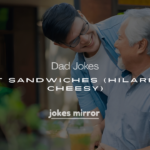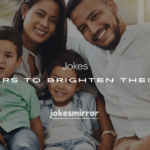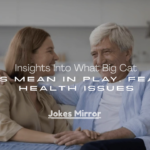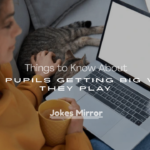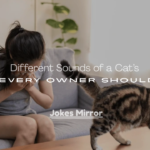Ever noticed your cat’s eyes go wide and wild during playtime? Those big, round pupils are more than just adorable—they’re a window into your cat’s instincts, emotions, and biology!
Whether they’re pouncing on a toy or chasing a laser, cats’ dilated pupils reveal a lot about their playful side.
Dive into these 250+ facts to uncover why your feline friend’s eyes get so big when they’re in the zone, and become a pro at reading their purr-fect play signals!

250+ Facts About Cats’ Pupils Getting Big While They Play
Biological Reasons for Pupil Dilation
- Cats’ pupils dilate during play to let in more light, enhancing their vision for quick movements.
- The iris muscles relax during play, causing pupils to expand into round shapes.
- Vertical slit pupils allow greater dilation, ideal for low-light play sessions.
- Dilated pupils maximize light intake, helping cats track fast-moving toys.
- The sympathetic nervous system triggers pupil dilation during playful excitement.
- Cats’ retinas, rich in rods, benefit from dilated pupils to see in dim light.
- Pupil dilation during play mimics the hunting response in wild cats.
- Large pupils improve depth perception, aiding precise pounces during play.
- Adrenaline surges during play, causing pupils to widen rapidly.
- Dilated pupils help cats process visual information during high-energy play.
Play Behaviors and Pupil Dilation
- Cats’ pupils get big when pouncing on toys, mimicking hunting behavior.
- Playful chasing triggers pupil dilation to track moving objects like strings.
- During play, pupils widen to focus on unpredictable toy movements.
- Kittens’ pupils dilate more often during play due to their high energy.
- Playful wrestling with other cats causes pupils to expand for better focus.
- Laser pointer games make pupils dilate as cats lock onto the moving dot.
- Dilated pupils during play signal heightened alertness to sudden movements.
- Cats’ pupils stay wide during feather toy play to track erratic patterns.
- Playful ambushing, like hiding and pouncing, triggers big pupils.
- Group play with other pets often leads to dilated pupils for visual clarity.
Emotional Triggers for Big Pupils
- Excitement during play causes pupils to dilate, reflecting joy.
- Playful cats show big pupils when thrilled by a favorite toy.
- Surprise during play, like a sudden toy move, widens pupils instantly.
- Happiness from playtime fun can make pupils grow large and round.
- Playful curiosity about a new toy triggers pupil dilation in cats.
- Adrenaline from playful “hunting” makes pupils expand with excitement.
- Cats’ pupils dilate when they’re delighted by interactive play.
- Playful anticipation, like waiting for a toy to move, widens pupils.
- Positive stimulation during play keeps pupils big and engaged.
- Cats show dilated pupils when play feels like a thrilling chase.
Environmental Factors in Play
- Dim lighting during play causes pupils to dilate for better vision.
- Indoor play in low light makes pupils appear larger than in bright rooms.
- Evening play, when cats are crepuscular, triggers wider pupils.
- Shadows from moving toys in dim light cause pupil dilation.
- Play in darker rooms amplifies pupil size to enhance sight.
- Outdoor play at dusk leads to naturally dilated pupils in cats.
- Low-light play areas make pupils round to capture more light.
- Cats’ pupils dilate during play in dimly lit corners of the house.
- Flickering lights during play can cause pupils to stay wide.
- Play near windows at twilight triggers larger pupils for clarity.
Hunting Instincts and Play
- Play mimics hunting, causing pupils to dilate like in the wild.
- Cats’ pupils widen during play to track “prey” like toys.
- Hunting-style play, like stalking, triggers big, round pupils.
- Dilated pupils during play help cats gauge toy distance accurately.
- Playful pouncing on moving objects mimics pupil dilation in hunts.
- Cats’ pupils grow big during play to spot tiny toy movements.
- Hunting instincts make pupils dilate even in bright play settings.
- Play with feather wands triggers hunting-like pupil dilation.
- Cats’ pupils stay wide during play to mimic predator focus.
- Chasing toys during play causes pupils to dilate for precision.
Age and Pupil Dilation
- Kittens’ pupils dilate more during play due to high excitement.
- Young cats show bigger pupils during play than older cats.
- Senior cats may have less pupil dilation during play due to calmness.
- Playful kittens often have fully round pupils during toy chases.
- Adult cats’ pupils dilate during play but constrict faster post-play.
- Older cats’ pupils may stay narrower during play due to less energy.
- Kittens’ playful curiosity causes frequent pupil dilation.
- Young cats’ pupils widen more during interactive play sessions.
- Senior cats’ pupils dilate less during play unless highly stimulated.
- Age affects pupil response speed during playful activities.
Adrenaline and Physiological Responses
- Adrenaline during play causes pupils to dilate rapidly for focus.
- Playful excitement triggers the fight-or-flight response, widening pupils.
- Cats’ pupils grow big during play due to adrenaline surges.
- High-energy play increases heart rate, linked to pupil dilation.
- Adrenaline makes pupils round during intense play moments.
- Playful chasing boosts adrenaline, causing larger pupils.
- Cats’ pupils dilate during play to prepare for quick reactions.
- Adrenaline from toy pouncing keeps pupils wide and alert.
- Playful energy spikes cause temporary pupil dilation in cats.
- Physiological arousal during play makes pupils appear bigger.
Types of Play and Pupil Reactions
- String play causes pupils to dilate for tracking fast movements.
- Laser pointer play triggers wide pupils for intense focus.
- Feather toy play leads to dilated pupils for erratic motion tracking.
- Ball-chasing play makes pupils grow to follow bouncing paths.
- Interactive wand play causes pupils to widen for engagement.
- Puzzle toy play triggers pupil dilation for problem-solving focus.
- Hide-and-seek play with toys makes pupils dilate for alertness.
- Tug-of-war play with ropes causes big pupils for grip focus.
- Solo play with balls leads to temporary pupil dilation.
- Group play with other cats triggers wider pupils for interaction.
Visual Processing During Play
- Dilated pupils during play enhance cats’ ability to track motion.
- Big pupils help cats process rapid visual changes during play.
- Playful focus on toys requires wider pupils for clarity.
- Cats’ pupils dilate to improve visual acuity during fast play.
- Large pupils during play aid in spotting subtle toy movements.
- Pupil dilation supports cats’ quick reaction times in play.
- Wide pupils during play improve depth perception for pouncing.
- Cats’ pupils grow to process complex visuals during toy chases.
- Playful tracking of objects relies on dilated pupils for focus.
- Visual processing during play is enhanced by larger pupils.
Light and Pupil Dilation
- Low light during play causes pupils to dilate naturally.
- Cats’ pupils stay wide in dim play areas for better sight.
- Bright light reduces pupil size, but play excitement overrides this.
- Twilight play sessions trigger larger pupils for low-light vision.
- Indoor play in soft light makes pupils appear bigger.
- Cats’ pupils dilate during play to adjust to changing light.
- Dimly lit playrooms cause pupils to stay round and large.
- Play near lamps may still show dilated pupils due to excitement.
- Outdoor evening play leads to naturally wider pupils.
- Light changes during play cause pupils to adjust rapidly.
Emotional Context of Play
- Playful joy causes pupils to dilate, showing happiness.
- Cats’ pupils widen during play when they feel thrilled.
- Excitement from playtime toys triggers big, round pupils.
- Playful surprise, like a toy’s sudden move, dilates pupils.
- Cats show dilated pupils during fun, interactive play sessions.
- Happiness during play keeps pupils large and expressive.
- Playful anticipation of a toy’s move causes pupil dilation.
- Positive emotions during play make pupils appear bigger.
- Cats’ pupils dilate when play feels rewarding and fun.
- Playful engagement with owners triggers wide pupils.
Instinctual Responses
- Play mimics hunting, making pupils dilate like in real hunts.
- Cats’ pupils widen during play to focus on “prey” toys.
- Instinctual pouncing during play triggers large pupils.
- Hunting instincts cause pupils to dilate even in bright light.
- Playful stalking of toys leads to wide, round pupils.
- Cats’ pupils grow during play to mimic predator alertness.
- Instinctual chasing during play causes pupil dilation.
- Playful ambushing triggers pupils to stay wide for focus.
- Cats’ hunting drive makes pupils dilate during toy play.
- Instinctual focus on moving toys widens pupils during play.
Play and Arousal Levels
- High arousal during play causes pupils to dilate significantly.
- Intense play sessions keep pupils wide for maximum focus.
- Cats’ pupils stay large during high-energy toy chases.
- Playful arousal mimics hunting, triggering pupil dilation.
- Excitement from play keeps pupils round and big.
- Cats’ pupils dilate during play due to heightened alertness.
- Fast-paced play increases arousal, widening pupils.
- Playful energy spikes cause pupils to stay dilated.
- Cats’ pupils grow during play to match high arousal levels.
- Intense play moments keep pupils large for engagement.
Types of Toys and Pupil Reactions
- Feather toys cause pupils to dilate for tracking erratic moves.
- Laser pointers trigger wide pupils during playful chases.
- String toys make pupils grow to follow unpredictable paths.
- Ball toys cause pupil dilation for bouncing motion focus.
- Wand toys lead to dilated pupils during interactive play.
- Puzzle toys trigger pupil dilation for mental engagement.
- Crinkle toys cause pupils to widen due to sound and motion.
- Stuffed toys during play make pupils dilate for pouncing.
- Rolling toys keep pupils large for tracking speed.
- Interactive toys cause pupils to stay wide during play.
Play and Cat Breeds
- Active breeds like Bengals show more pupil dilation during play.
- Siamese cats’ pupils widen often during playful chases.
- Maine Coons’ pupils dilate during high-energy play sessions.
- Persian cats may show less pupil dilation during calm play.
- Abyssinian cats’ pupils grow big during fast toy play.
- Playful breeds like Savannahs have wide pupils during games.
- Ragdolls’ pupils dilate less during gentle playtime.
- Sphynx cats show big pupils during energetic play moments.
- Domestic shorthairs’ pupils widen during active play.
- Breed energy levels affect pupil dilation during play.
Play and Social Interaction
- Play with owners causes pupils to dilate from excitement.
- Cats’ pupils widen during play with other pets for focus.
- Social play with humans triggers big pupils in cats.
- Group play with cats leads to dilated pupils for alertness.
- Playful interaction with kids causes pupil dilation in cats.
- Cats’ pupils grow during play with familiar people.
- Social play with toys triggers wide pupils for engagement.
- Cats show dilated pupils during fun human interactions.
- Play with family members causes pupils to stay large.
- Social play keeps pupils wide for bonding and focus.
Play and Energy Levels
- High-energy play causes pupils to dilate for quick reactions.
- Cats’ pupils stay wide during intense play sessions.
- Low-energy play may show less pupil dilation in cats.
- Playful bursts of energy trigger big, round pupils.
- Cats’ pupils dilate during high-speed toy chases.
- Energetic play keeps pupils large for visual tracking.
- Short play sessions cause temporary pupil dilation.
- Cats’ pupils widen during long, active play periods.
- High-energy cats show more pupil dilation during play.
- Playful energy spikes keep pupils round and big.
Play and Visual Cues
- Moving toys during play cause pupils to dilate for focus.
- Cats’ pupils widen to track visual cues during play.
- Fast-moving objects trigger big pupils for visual clarity.
- Play with bright toys causes pupils to stay wide.
- Visual stimuli during play lead to dilated pupils.
- Cats’ pupils grow to follow toy patterns during play.
- Playful focus on moving objects widens pupils.
- Visual tracking during play keeps pupils large.
- Cats’ pupils dilate to spot subtle toy movements.
- Play with colorful toys triggers pupil dilation.
Play and Time of Day
- Evening play causes pupils to dilate due to crepuscular nature.
- Cats’ pupils widen during dusk play for low-light vision.
- Morning play sessions trigger big pupils in dim light.
- Nighttime play keeps pupils large for better sight.
- Twilight play causes pupils to stay round and wide.
- Daytime play in dim rooms triggers pupil dilation.
- Cats’ pupils grow during early evening play sessions.
- Play at dawn leads to naturally dilated pupils.
- Low-light play times cause pupils to stay large.
- Cats’ pupils dilate during nighttime toy chases.
Play and Physical Reactions
- Playful pouncing causes pupils to dilate for focus.
- Cats’ pupils widen during play due to muscle relaxation.
- Fast movements during play trigger big pupils.
- Playful jumping keeps pupils large for visual tracking.
- Cats’ pupils dilate during play to enhance reaction speed.
- Physical exertion in play causes pupil dilation.
- Playful running triggers wide pupils for alertness.
- Cats’ pupils stay large during active play movements.
- Physical play with toys keeps pupils round.
- Playful swatting causes pupils to dilate for focus.
Play and Emotional Bonding
- Play with owners causes pupils to dilate, showing trust.
- Cats’ pupils widen during playful bonding moments.
- Interactive play triggers big pupils, reflecting affection.
- Playful engagement with humans keeps pupils large.
- Cats show dilated pupils during fun owner interactions.
- Play with loved ones causes pupils to stay wide.
- Bonding through play triggers pupil dilation in cats.
- Cats’ pupils grow during playful moments with family.
- Playful trust with owners leads to big pupils.
- Emotional play keeps pupils wide and expressive.
Play and Catnip Effects
- Catnip during play causes pupils to dilate with euphoria.
- Cats’ pupils widen when playing with catnip toys.
- Nepetalactone in catnip triggers big pupils during play.
- Play with catnip balls causes temporary pupil dilation.
- Cats’ pupils stay large during catnip-induced play.
- Catnip play sessions keep pupils round and wide.
- Playful catnip reactions cause pupils to dilate.
- Cats’ pupils grow during catnip toy chases.
- Catnip excitement during play triggers big pupils.
- Play with catnip keeps pupils dilated for fun.
Play and Health Considerations
- Normal pupil dilation during play is not a health concern.
- Persistent pupil dilation after play may need vet attention.
- Playful pupil dilation should subside when cats calm down.
- Uneven pupils during play could indicate anisocoria, needing a vet check.
- Healthy cats’ pupils dilate during play but constrict in bright light.
- Playful pupil changes are normal unless accompanied by symptoms.
- Cats’ pupils during play should respond to light changes.
- Abnormal pupil dilation during play may signal health issues.
- Playful pupil dilation is safe unless persistent in bright light.
- Consult a vet if pupils stay dilated post-play with other symptoms.
Play and Body Language
- Dilated pupils during play pair with a wagging tail for excitement.
- Cats’ pupils widen with perked ears during playful focus.
- Playful pupil dilation often comes with a crouched stance.
- Big pupils during play signal alertness with raised fur.
- Cats show dilated pupils and twitching tails during play.
- Playful body language with big pupils includes arched backs.
- Wide pupils during play pair with playful vocalizations.
- Cats’ pupils dilate with focused stares during toy play.
- Playful pupil dilation aligns with quick paw movements.
- Body language during play enhances pupil dilation signals.
Why Cats’ Pupils Get Big During Play
Observing Pupil Changes
Notice pupils dilate during laser pointer play to track fast dots. Watch for round pupils when cats pounce on feather toys. Check if pupils constrict post-play in bright light for normalcy.
Interpreting Playful Behavior
Big pupils with a wagging tail signal playful excitement. Wide pupils during toy chases show hunting instincts at work. Dilated pupils with perked ears indicate focused play.
Timing of Pupil Dilation
Pupils dilate most during high-energy play like chasing strings. Evening play sessions show larger pupils due to low light. Quick pupil changes occur during sudden toy movements.
Emotional Context of Big Pupils
Dilated pupils during play reflect joy and excitement. Wide pupils show cats are thrilled by interactive toys. Big pupils during play with owners signal trust and fun.
Playful Instincts and Pupils
Play mimics hunting, making pupils dilate for focus. Cats’ pupils widen to track “prey” like moving toys. Pouncing during play triggers big pupils for precision.
Health Considerations During Play
Normal pupil dilation during play subsides when cats relax. Persistent big pupils post-play may need a vet check. Uneven pupils during play could signal anisocoria.
Enhancing Playtime Observations
Use feather toys to see pupil dilation during erratic play. Play in dim light to observe natural pupil widening. Watch for pupil changes during interactive owner play.
Adapting Play for Pupil Responses
Choose fast-moving toys to trigger big pupils during play. Play in low light to see natural pupil dilation. Use catnip toys for euphoric pupil widening during play.
Handling Health Concerns
If pupils stay dilated post-play, consult a vet for checks. Watch for uneven pupils during play as a health sign. Normal pupil dilation during play is safe and temporary.
Personalizing Play Observations
Notice if your cat’s pupils dilate more with specific toys. Track pupil changes during play with you for bonding signs. Observe pupil size in different light during playtime.
Sharing Playtime Insights
Share that big pupils during play show excitement and focus. Note that evening play causes wider pupils due to light. Explain that catnip play triggers euphoric pupil dilation.
When to Seek Veterinary Advice
If pupils stay dilated in bright light after play, see a vet. Uneven pupils during play need immediate vet attention. Persistent big pupils post-play may signal health issues.
Bonus Content: Tools for Understanding Cat Pupils During Play
5 Scenarios for Observing Pupil Dilation
- Laser Pointer Play: Watch pupils widen as your cat chases the dot.
- Feather Toy Chase: Notice big pupils during erratic toy movements.
- Evening Playtime: See larger pupils in dim light during play.
- Owner Interaction: Observe pupils dilate during bonding play.
- Catnip Toy Fun: Check for euphoric pupil dilation with catnip.
5 Tips for Understanding Pupil Changes
- Watch Body Language: Pair dilated pupils with tail wags for excitement.
- Check Light Levels: Play in dim light to see natural pupil dilation.
- Use Interactive Toys: Feather wands trigger big pupils for focus.
- Monitor Post-Play: Ensure pupils constrict in bright light after play.
- Note Emotions: Big pupils during play show joy and engagement.
5 Examples of Pupil Dilation in Play
- Laser Chase: Pupils go round chasing a laser dot.
- Feather Pounce: Big pupils during feather toy play.
- Evening Game: Wide pupils in dim light during play.
- Owner Play: Dilated pupils during bonding toy time.
- Catnip Fun: Large pupils with catnip toy play.
5 Things to Avoid During Play Observations
- Ignoring Health Signs: Persistent big pupils need vet checks.
- Overlooking Uneven Pupils: Anisocoria during play is serious.
- Playing in Bright Light Only: Dim light shows natural dilation.
- Missing Body Language: Pair pupils with tail or ear cues.
- Assuming All Dilation Is Normal: Check for post-play constriction.
5 Ways to Interpret Pupil Responses
- Excitement: Big pupils show playtime joy and focus.
- Hunting Instinct: Wide pupils mimic predator focus.
- Low Light: Dilated pupils aid vision in dim play areas.
- Bonding: Large pupils during owner play signal trust.
- Catnip Effect: Euphoria from catnip widens pupils.
Conclusion
These 250+ facts about cats’ pupils getting big while they play reveal the fascinating mix of biology, instinct, and emotion behind those wide-eyed moments. From hunting instincts to joyful excitement, your cat’s dilated pupils tell a story of fun and focus. Explore our other guides to deepen your bond with your feline friend!
FAQs
- Q. Why do my cat’s pupils get big during play?
Dilated pupils during play reflect excitement, hunting instincts, or low-light vision needs. - Q. Is pupil dilation during play normal?
Yes, it’s normal for pupils to dilate during play due to adrenaline or dim light, but they should constrict post-play. - Q. How can I tell if my cat’s big pupils are a health issue?
If pupils stay dilated in bright light or are uneven during play, consult a vet for possible issues like anisocoria. - Q. Do certain toys cause more pupil dilation?
Fast-moving toys like laser pointers or feather wands trigger bigger pupils for focus. - Q. Why do kittens’ pupils dilate more during play?
Kittens are more excitable, causing frequent pupil dilation during high-energy play.

